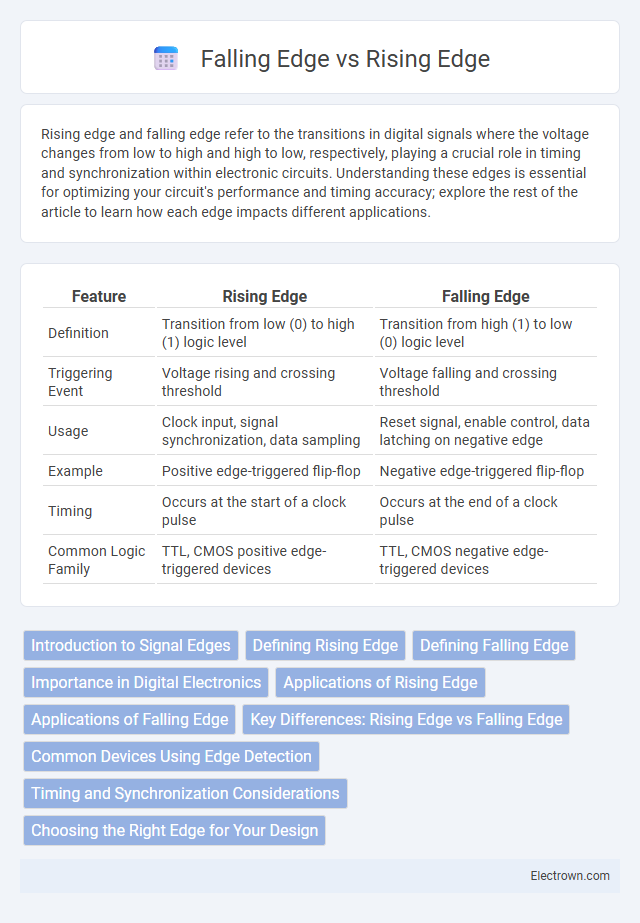Rising edge and falling edge refer to the transitions in digital signals where the voltage changes from low to high and high to low, respectively, playing a crucial role in timing and synchronization within electronic circuits. Understanding these edges is essential for optimizing your circuit's performance and timing accuracy; explore the rest of the article to learn how each edge impacts different applications.
Table of Comparison
| Feature | Rising Edge | Falling Edge |
|---|---|---|
| Definition | Transition from low (0) to high (1) logic level | Transition from high (1) to low (0) logic level |
| Triggering Event | Voltage rising and crossing threshold | Voltage falling and crossing threshold |
| Usage | Clock input, signal synchronization, data sampling | Reset signal, enable control, data latching on negative edge |
| Example | Positive edge-triggered flip-flop | Negative edge-triggered flip-flop |
| Timing | Occurs at the start of a clock pulse | Occurs at the end of a clock pulse |
| Common Logic Family | TTL, CMOS positive edge-triggered devices | TTL, CMOS negative edge-triggered devices |
Introduction to Signal Edges
Signal edges represent critical transitions in digital electronics, where a rising edge indicates a change from low to high voltage and a falling edge indicates a switch from high to low voltage. These edges trigger events in circuits, such as latching data or generating interrupts, making them essential for timing and synchronization in microcontrollers and digital systems. Understanding how your device responds to rising and falling edges ensures precise control over signal processing and event detection.
Defining Rising Edge
The rising edge refers to the transition of a signal from a low voltage level (0) to a high voltage level (1) in digital electronics, marking the point when the signal crosses a specified threshold. This transition is critical in triggering events such as clock synchronization in digital circuits, data sampling, and state changes in flip-flops or registers. Accurate detection of the rising edge ensures proper timing and reliability in sequential logic and timing-sensitive applications.
Defining Falling Edge
Falling edge refers to the transition of a signal from a high voltage level to a low voltage level, marking a critical timing event in digital circuits. This transition is essential for triggering specific actions in flip-flops, counters, and other sequential logic components. Understanding the falling edge allows you to design precise timing controls and optimize signal synchronization in your electronic systems.
Importance in Digital Electronics
Rising edge and falling edge triggers are crucial in digital electronics for synchronizing circuits and ensuring precise timing in flip-flops, counters, and shift registers. Devices respond to these transitions to capture or change data accurately, enabling reliable operation in microprocessors and communication systems. The distinction between rising and falling edges optimizes signal processing, reduces timing errors, and enhances overall circuit performance.
Applications of Rising Edge
Rising edge triggers play a crucial role in digital circuits for synchronizing data transfer and clocking events in flip-flops and registers. Microprocessors utilize rising edge detection to initiate instruction execution, ensuring precise timing control in synchronous systems. In communication protocols like SPI and I2C, rising edges are essential for sampling data and generating accurate clock signals.
Applications of Falling Edge
Falling edge triggering is commonly used in digital circuits where the action occurs at the transition from a high to a low voltage level, such as in flip-flops and counters to synchronize data capture or event detection. In microcontrollers and processors, falling edge signals often trigger interrupts, enabling rapid response to external events like button presses or sensor outputs. Your designs benefit from falling edge-based timing to reduce noise susceptibility and improve signal integrity in communication protocols like SPI and UART.
Key Differences: Rising Edge vs Falling Edge
Rising edge refers to the transition of a signal from low to high voltage, while falling edge denotes the change from high to low voltage. Key differences include timing sensitivity, with rising edges often triggering events at signal start and falling edges at signal end, affecting the synchronization in digital circuits. Understanding these distinctions is crucial for optimizing your circuit design and ensuring precise signal processing.
Common Devices Using Edge Detection
Common devices using edge detection include microcontrollers, digital oscilloscopes, and logic analyzers that rely on detecting rising edges to trigger events or capture signal changes. Falling edge detection is commonly employed in flip-flops, pulse detectors, and communication interfaces to identify signal transitions from high to low. Your choice between rising and falling edge detection depends on the specific timing requirements and signal characteristics of the device or application you are working with.
Timing and Synchronization Considerations
Rising edge and falling edge triggers play crucial roles in timing and synchronization of digital circuits, where the precise moment of signal transition determines data capture and transfer accuracy. Rising edge triggers activate on the low-to-high voltage transition, while falling edge triggers respond to high-to-low changes, affecting clock timing and setup/hold requirements. Understanding these differences helps optimize your system's timing margins and ensures reliable synchronization across all components.
Choosing the Right Edge for Your Design
Selecting the appropriate edge trigger--rising edge or falling edge--depends on the specific timing requirements and signal characteristics of your design. Rising edge triggers respond when a signal transitions from low to high, making them ideal for scenarios requiring activation at signal assertions, while falling edge triggers respond when signals transition from high to low, useful for capturing de-assertions or end-of-cycle events. Considering factors like clock polarity, noise susceptibility, and synchronization with other components ensures optimal performance and reliability in digital circuit operation.
Rising edge vs falling edge Infographic

 electrown.com
electrown.com